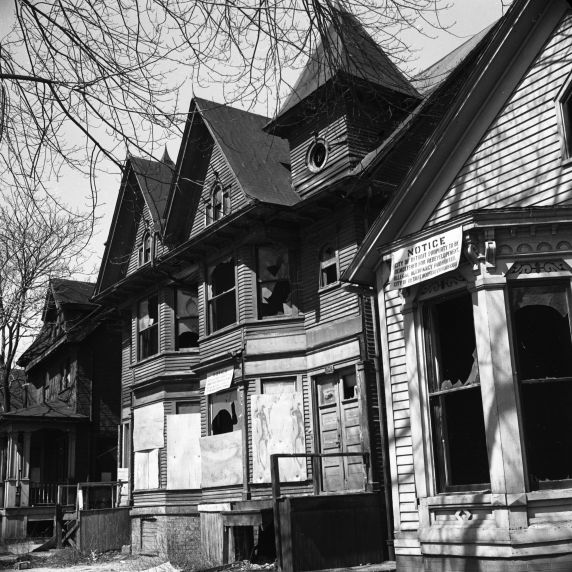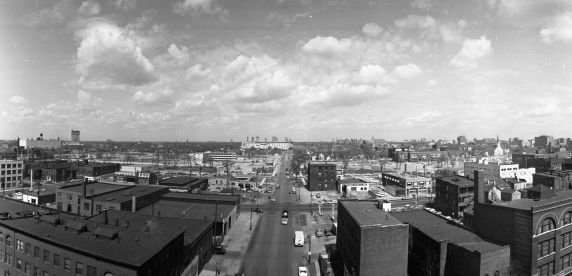Detroit's Corktown Neighborhood
In the Winter 2013 semester, the Reuther Library worked with students in the Graduate Certificate in Archival Administration program at the Wayne State School of Library and Information Science to produce a series of student-written, guest blog posts.
Caitlin Brennecke is a graduate student at Wayne State University in the Library and Information Science program with a focus on archival administration. Her interests include digitization of historical collections and the use of crowd sourcing in archives and libraries. For the past year she volunteered for the Detroit Historical Society at their Collection Resource Center and she recently began working in a private archive.
Corktown is a neighborhood in Detroit that is well known for quite a few reasons. For nearly 100 years, metro Detroiters came to Corktown to watch the Tigers play at Tiger Stadium before the team moved to downtown’s Comerica Park in 2000. The now abandoned Michigan Central Station, through which many immigrants arrived by train, continues to attract those who wish to see what’s left of its grandeur. Corktown is currently experiencing a resurgence in activity, as it is home to several, new, popular Detroit restaurants.
Corktown is located west of downtown Detroit and is bounded by Rosa Parks Boulevard, Michigan Avenue, Trumbull Avenue, Porter Street, Bagley Avenue, and the John Lodge Expressway. It is the oldest surviving neighborhood in Detroit, with many of its buildings and homes dating back to the mid- to late-19th century. Corktown became home to different ethnic groups, most notably Irish, Maltese, and Mexican. These immigrants came to Detroit for work because of the city’s success during the industrial revolution.
During Corktown’s industrial and commercial boom in the early- to mid-1900s, the neighborhood experienced a shift away from private homes to businesses and rental properties. This shift began Corktown’s decline, with buildings deteriorating or becoming abandoned, and an increase in transients residing in the neighborhood. Because of this change, a study was done in 1954 of the industrial area of the neighborhood to determine the level of blight. The study, titled “Corktown U.R. Mich. 6: A Study of the West Side Industrial Redevelopment Project – Detroit City Plan Commission,” was written at the request of the city council and looked at numerous factors including dilapidation of structures, over-occupancy of dwellings, lack of yard space, inadequate dwelling facilities such as a lack of hot water, low rent, and a decline in property values. The areas determined blighted by the study were to be demolished to clean up the area and make room for new development. By the late 1950s, numerous homes and buildings were demolished in hopes of having the newly proposed Cobo Hall built in their place. Unfortunately for Corktown, by the time these buildings were demolished, Cobo Hall was already under construction at its current location on the Detroit River.
The increase in industry and commerce, coupled with urban expansion and the construction of freeways, also caused Corktown to eventually become cut off from the city’s center. During the 1950s and 1960s, the neighborhood experienced a decrease in population and an increase in physical deterioration as a result. Many residents felt that the historic neighborhood was suffering as a result of truck traffic, the Fisher Freeway, which was built in 1959 and cut through it, and the use of land for Tiger Stadium parking.
Residents of Corktown had not yet given up on their neighborhood, however, and in 1970 a group of citizens proposed a neighborhood redevelopment plan for a “community on the move.” These residents proposed that the existing Corktown houses should be preserved and rehabilitated and that through-traffic should be limited. Residents also wanted to establish a community center featuring a drug store, supermarket, bank, family center, park, school, and a church, as well as a “super-block” that would contain a delicatessen, pub, pharmacy, and space for ethnic clubs.
While this plan was never approved, Detroit's Community and Economic Development Department proposed a new plan in 1977 to relocate houses to the neighborhood to fill in the vacant lots. Project Planner C. Ozimek explained in correspondence to Carl Almblad, an urban planner, that the project would fill these lots with “architecturally compatible houses from the surrounding area to protect, improve, and preserve the historic character of Corktown.” This project never came to fruition, but this proposal and other proposals to restore the neighborhood show how devoted Corktown citizens were to their neighborhood.
In the same year, Martha Bigelow, director of the Michigan History Division, suggested in a letter to Mayor Coleman Young that Corktown could possibly be nominated as an historic district on the National Register of Historic Places. Mayor Young felt that this designation would help to continue preservation efforts of significant buildings in the neighborhood. The following year, on July 31, 1978, the Corktown Historic District was listed on the National Register of Historic Places. Historical markers and historical designations in Corktown lead to preservation attempts in the neighborhood since the city recognizes the neighborhood's importance in the history of the Detroit.
Corktown has a unique, interesting, and often heartbreaking history, but it is not the only neighborhood in Detroit that has experienced these ups and downs of development, neglect, deterioration, and revitalization. The Carl Almblad Papers, located within the Reuther Library contain important primary sources that help to explain the development and planning of Corktown and other neighborhoods and districts in Detroit, including Cass Corridor, the Boston Edison Historic District, and the West Canfield Historic District. The Almblad Papers also include records and correspondence from the City of Detroit Community and Economic Development Department, and the Detroit Historic District Commission. The Reuther Library also has many historic images of Corktown in its collections.
Additional References:
City of Detroit Planning and Development Department. (n.d.). Corktown Historic District. Retrieved from http://www.ci.detroit.mi.us/historic/districts/corktown.pdf
Detroit 1701. (n.d.). Corktown. Retrieved from http://detroit1701.org/Corktown.htm
Szewczyk, P. (2013, February 25). Corktown history: Ethel Claes and the West Side Industrial Project. Retrieved from http://corktownhistory.blogspot.com/2013/02/ethel-claes-and-west-side-industrial.html
- Public Relations Team's blog
- Login to post comments
- Printer-friendly version



 Reddit
Reddit Facebook
Facebook LinkedIn
LinkedIn